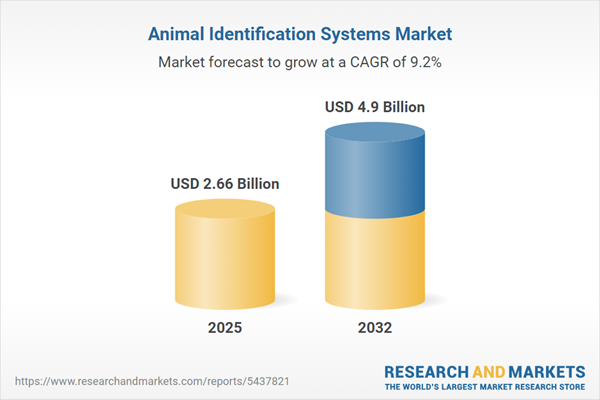Speak directly to the analyst to clarify any post sales queries you may have.
Animal identification systems are undergoing rapid transformation, propelled by digital innovation and stricter regulatory frameworks. Senior decision-makers face a pivotal landscape as technology and compliance demands reshape industry standards and operational strategies.
Market Snapshot: Animal Identification Systems Market Size and Growth
The Animal Identification Systems Market grew from USD 2.43 billion in 2024 to USD 2.66 billion in 2025. It is expected to continue growing at a CAGR of 9.16%, reaching USD 4.90 billion by 2032. This trajectory reflects expanding adoption across global livestock and aquaculture markets. Robust market expansion is driven by the push for end-to-end traceability, operational optimization, and heightened animal welfare standards, positioning advanced identification solutions as a critical pillar within supply chain ecosystems.
Scope & Segmentation
This report delivers in-depth coverage of the Animal Identification Systems Market, focusing on technology, product types, end-user segments, application areas, and key distribution channels across major geographies.
- Technology: Barcode (one dimensional, two dimensional), Biometric (facial, footprint, iris recognition), Radio Frequency Identification (active, passive, semi passive)
- Product: Bolus, Ear Tag (barcode, RFID: active, passive, semi passive), Implant, Printed Tag
- End User: Aquaculture, Beef, Dairy, Poultry, Swine
- Application: Health Monitoring, Security, Tracking
- Distribution Channel: Direct Sales, Distributors, Online
- Regions: Americas (United States, Canada, Mexico, Brazil, Argentina, Chile, Colombia, Peru), Europe, Middle East & Africa (United Kingdom, Germany, France, Russia, Italy, Spain, Netherlands, Sweden, Poland, Switzerland, United Arab Emirates, Saudi Arabia, Qatar, Turkey, Israel, South Africa, Nigeria, Egypt, Kenya), Asia-Pacific (China, India, Japan, Australia, South Korea, Indonesia, Thailand, Malaysia, Singapore, Taiwan)
- Key Industry Players: Allflex USA LLC, Datamars SA, Biomark Inc., Zoetis Inc., IDEXX Laboratories Inc., Bayer AG, Avid Identification Systems Inc., NXP Semiconductors NV, Impinj Inc., Microchip Technology Incorporated
Key Takeaways for Industry Leaders
- The market is characterized by increasing integration of cloud-based platforms, IoT connectivity, and real-time analytics, facilitating predictive management for producers, processors, and regulators.
- Adoption rates are accelerating among both smallholder farmers and large agribusinesses as solutions become more user-centric with modular options and open architectures.
- Interoperable standards are emerging, reducing barriers to entry for solution providers while supporting regulatory harmonization, especially in regions with strict traceability mandates.
- Partnerships and targeted acquisitions are fostering rapid technological innovation and geographic expansion, reinforcing competitive differentiation among key market participants.
- Growth in the poultry, dairy, and aquaculture segments highlights the need for tailored solutions that address unique welfare, monitoring, and compliance challenges.
- Online and direct sales channels are expanding, enabling broader market reach and improved access to turnkey animal identification kits.
Tariff Impact
New United States tariff measures, effective in 2025, are altering supply chain cost structures for animal identification system components and hardware. Manufacturers are re-evaluating sourcing, often shifting to domestic or regional suppliers to offset potential price increases. This is prompting a move toward modular device procurement and the strengthening of local production capabilities. Adaptation to these regulations enhances supply chain resilience and compliance agility for industry players.
Methodology & Data Sources
This report utilizes a mixed-method approach, combining in-depth interviews with manufacturers, software developers, livestock operators, and regulators. Quantitative data from public and proprietary sources supplement firsthand insights. Scenario analysis and sensitivity testing ensure robust coverage of evolving adoption trends, regulatory changes, and technology roadmaps.
Why This Report Matters
- Enables actionable strategic planning by delivering technology, product, and regional insights aligned with leadership priorities.
- Equips organizations to navigate regulatory changes and supply chain disruptions with data-backed recommendations.
- Provides a clear framework to identify growth opportunities in high-potential end-user sectors and regions worldwide.
Conclusion
The future of animal identification systems will be defined by technological advancement, adaptive supply chains, and strategic collaboration. Decision-makers using this report are well-positioned to drive sustainable innovation and strengthen market leadership across evolving global landscapes.
Additional Product Information:
- Purchase of this report includes 1 year online access with quarterly updates.
- This report can be updated on request. Please contact our Customer Experience team using the Ask a Question widget on our website.
Table of Contents
3. Executive Summary
4. Market Overview
7. Cumulative Impact of Artificial Intelligence 2025
Companies Mentioned
The companies profiled in this Animal Identification Systems market report include:- Allflex USA, LLC
- Datamars SA
- Biomark, Inc.
- Zoetis Inc.
- IDEXX Laboratories, Inc.
- Bayer AG
- Avid Identification Systems, Inc.
- NXP Semiconductors N.V.
- Impinj, Inc.
- Microchip Technology Incorporated
Table Information
| Report Attribute | Details |
|---|---|
| No. of Pages | 198 |
| Published | November 2025 |
| Forecast Period | 2025 - 2032 |
| Estimated Market Value ( USD | $ 2.66 Billion |
| Forecasted Market Value ( USD | $ 4.9 Billion |
| Compound Annual Growth Rate | 9.1% |
| Regions Covered | Global |
| No. of Companies Mentioned | 11 |









